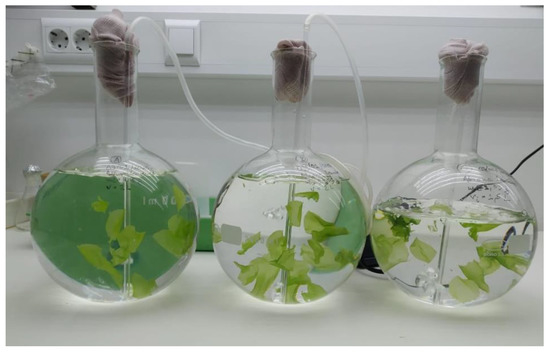The ecosystem services can be divided using two major classification systems, the Millennium Ecosystem Assessment (MEA) and the Common International Classification of Ecosystem Services (CICES). In the MEA system, the ecosystem services are divided into four major service clusters: supporting, provisioning, regulating, and cultural. On the other hand, the CICES system regards the “MEA supporting services” as organism natural function (and not an ecosystem service). Thus, this function is the basis for all the three CICES ecosystem services (provisioning, regulating, and cultural) provided by one organism. These ecosystem services can be analyzed for the type of habitat, fauna or flora. Seaweeds, or marine macroalgae, are one of the key organisms in estuarine and seawater habitats ecosystems, which currently is of extreme importance due to the climate changes and the blue–green economy. Seaweeds and humankind have been interlinked from the beginning, mainly as a food source, fibers, biochemicals, natural medicine, ornamental resources, art inspiration, and esthetic values in several coastal communities. Moreover, currently they are being studied as green carbon, carbon sequestration, and as a possible source for the biomedical and pharmaceutical areas.
- seaweeds
- ecosystem services
- invasive species
- ecological functions
- seaweed services
1. Introduction
2. Ecosystem Services Provided by Seaweeds
Ecosystem services are “the human gains obtained from ecosystems” according to the Millennium Ecosystem Assessment (MEA). They are divided into four categories: supporting, provisioning, regulating, and cultural services [14][15][23,24]. Where Common International Classification of Ecosystem Services (CICES) have the supporting services changed for organism functions, and the services are divided into three categories: provisioning, regulating, and cultural services [16][17][25,26]. Although MEA and CICES are two different ecosystem services classification systems, they are similar on their bases, where the MEA is divided in four categories and CICES is divided in three categories. Supporting services/function are “those required for the development of all other ecosystem services”, thus organism natural function due to be basis of all the services and it is all interlinked at the basis. These organism function/services constitute the foundation for all others, and their benefits to people are indirect or occur over time (per example, primary production and photosynthesis). Furthermore, without these organism functions, all the other ecosystem services do not happen [16][25]. The advantages derived through the management of ecological processes, such as the regulation of climate, water, and some human illnesses are referred to as regulating services. Provisioning services are “products obtained from ecosystems, such as genetic resources, food and fiber, and fresh water,” whereas cultural services are “the non-material benefits people obtain from ecosystems, such as cognitive development, reflection, recreation, and esthetic experience” [18][27]. Although seaweeds demonstrate activity in various ecological services (Figure 1), some of them are indirect and others affect the local community strictly, thus they are local ecological services.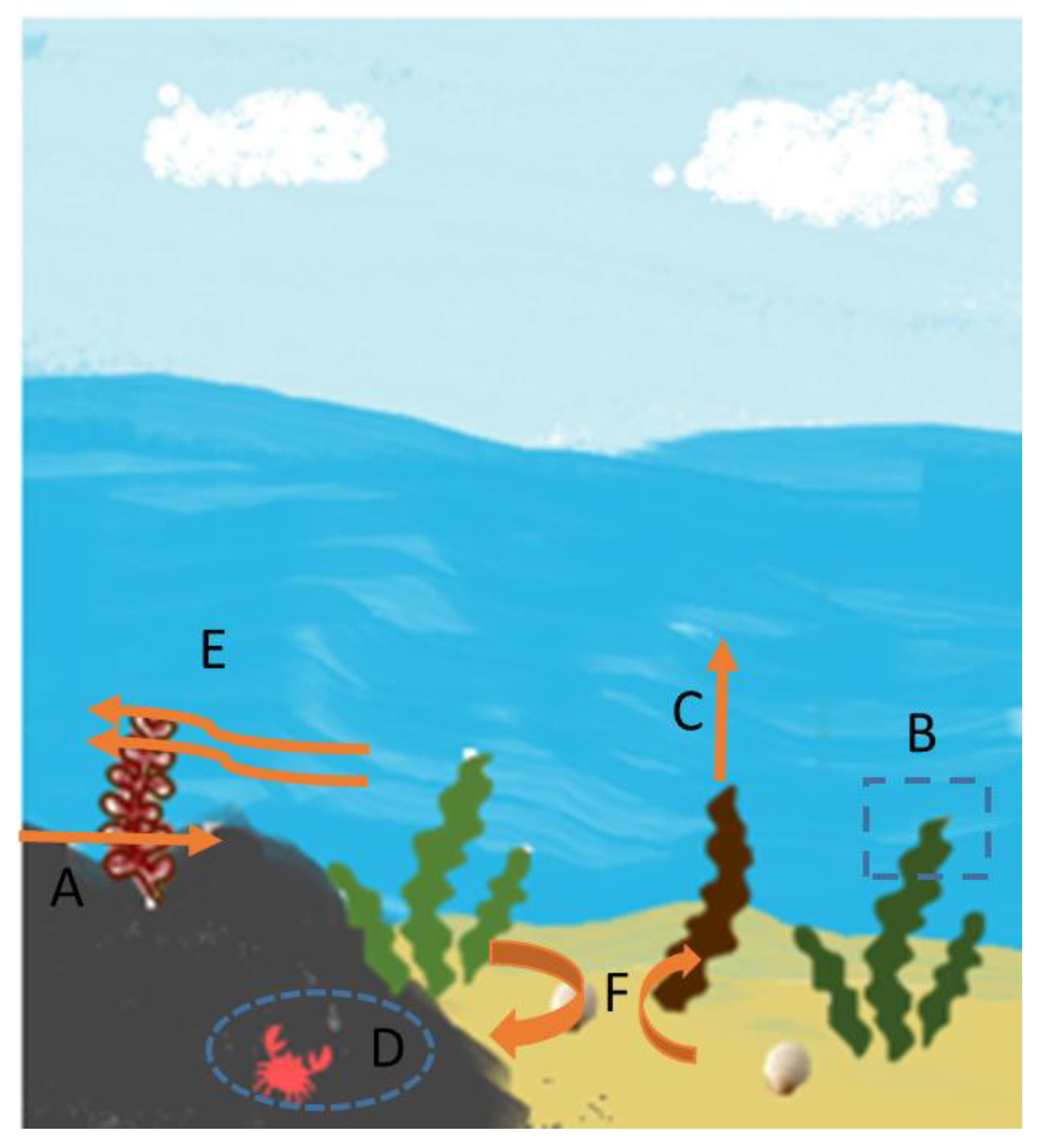

3. Seaweed Ecosystem Services
3.1. Seaweed Functions/Supporting Services
There is significant evidence that seaweeds play critical roles in supplying all categories of supporting services. Sediment formation is influenced by seaweeds, mostly seaweed forests. Sediments are formed of particles of both allochthonous and autochthonous origin, with seaweed detritus playing a prominent role in the latter. Seaweeds are the principal source of biological materials in coastal areas. Kelps (large brown seaweeds) limit water velocity, which aids in the trapping of mud and sand in beaches. For these reasons, seaweeds aid in sediment retention and deposition [19][20][21][22][37,38,39,40]. The correlation between wind and storms indicates that climate change will most likely has a significant influence on wave height and other wave characteristics [23][41]. Floods and coastal erosion are severe threats to coastal communities, with occurrences that require the implementation of long-term solutions to the problem [24][42]. By providing coastal protection, vegetated coastal habitats may assist to alleviate the effects of sea-level rise and the concomitant increase in wave activity [25][43]. Furthermore, vegetated coastal habitats have a high capacity for producing carbonates and other materials that aid in sediment accumulation, beach nutrition, and the formation of dunes on land [26][27][44,45], preventing coastal erosion. Photosynthesis and primary production by seaweeds provide wide indirect advantages to humans. Photosynthesis and primary production of seaweeds, for example, feed aquatic food webs in a variety of environments. Seaweeds environments are very productive, producing 1.5 and 1.05 g C m–2 h–1 (median values) by photosynthesis, respectively [28][46]. On a worldwide scale, seaweeds habitats (such as kelp forests and seaweed beds) are the most widespread and productive coastal ecosystems, and are one of the principal photosynthesis organisms in planet Earth [29][30][31][47,48,49]. Much of this carbon is used to support the food web in coastal habitats, with grazers consuming on average 34% of seaweed production [28][46]. Seaweeds, on the other hand, are more nutritious (compared with other seaweeds) and hence vulnerable to more grazing, particularly in temperate climates, while their tropical counterparts tend to contain more anti-herbivory chemicals [32][50]. Photosynthesis also contributes to another important supporting service: production of atmospheric oxygen. Seaweeds belong to the aquatic photosynthetic group (this group is composed of seaweeds, marine plants, and phytoplankton) responsible for 50–80% of the oxygen production on Earth. Oxygen is required for decomposing microbes to metabolize toxins and organic pollutants [33][34][56,57], and it is a critical component in nitrogen, phosphorus, sulfur, and iron cycling [35][58]. Thus, seaweed photosynthesis helps in effective nutrient cycling. Production of oxygen by seaweed is also vital for fish, particularly those more sensitive species [36][59], and so seaweeds may have an indirect impact on human usage of this resource. Seaweeds participate in the water cycle as a result of two mechanisms. Seaweeds can be exposed by different tides and if there is a low tide, they can be emerged from the aquatic habitat and being exposed to air, provoking water losses. The opposite occurs when seaweed are submerged, when they reduce water losses to the environment. The magnitude of these processes interferes with the water cycle and may have a crucial influence in water balance in specific ecosystems. The provisioning of habitat can be considered one of the most important ESs provided by seaweeds because a variety of other ecological services depend on this service. Seaweeds are vital for maintaining the food chain’s equilibrium and for ecological functions such as nursery, recruitment, and protection regions for many aquatic species [37][38][19,65]. Natural macroalgal niches perform an important ecological function in marine environments [37][38][19,65] (Figure 2), and as a result, are a significant component in economic exploration and environmental conservation of the oceans and seas.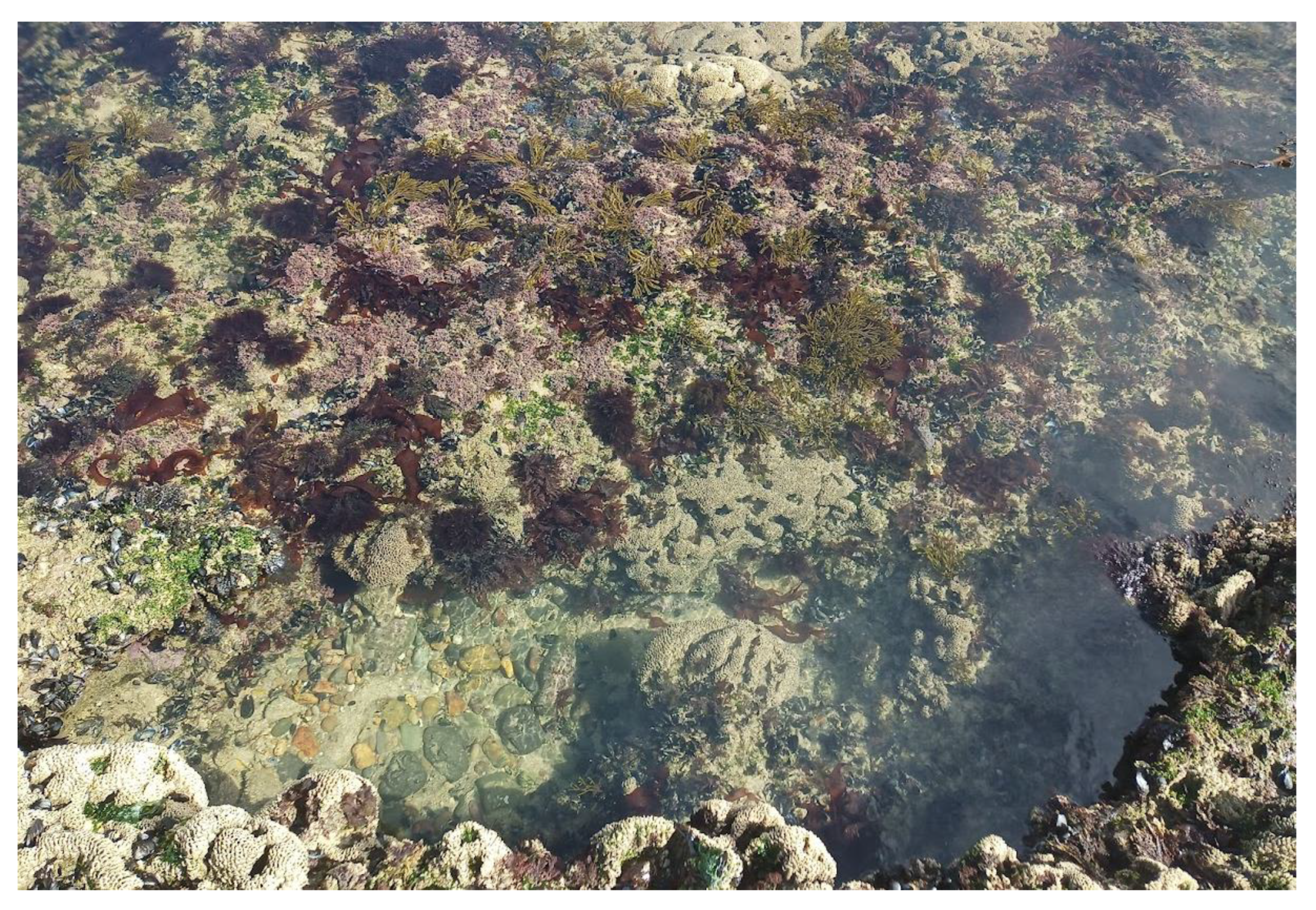
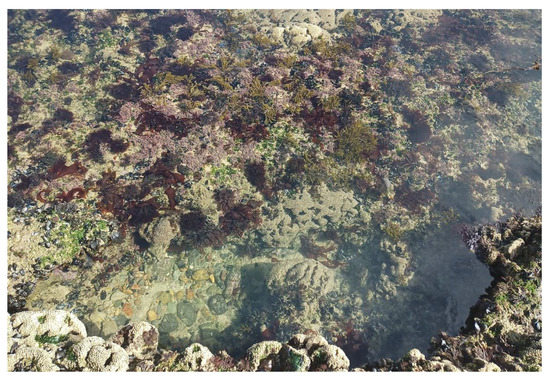
3.2. Regulating Services
Unlike supporting services, regulating services provide advantages that are more directly tied to human benefits; however, they are not always clearly recognized such as the climate regulation provided by seaweeds.
Highly prolific seaweed species may contribute significantly to the yearly biological reduction in CO2 and the global carbon cycle [39][67]. However, in order to comprehend the scope of this decrease, researchers must first estimate the amount and rate at which fixed carbon is recycled [40][68]. Even though marine seaweed communities comprise a very tiny portion of the coastal region (approximately 33%, 3,5 mill km2), these habitats are an important component of climatic change adaptation and mitigation strategy [41][69]. Thus, seaweed are responsible for the uptake of 173 million tons of carbon per year, making seaweed a vital player in the global carbon cycle [30][48]. Seaweed are carried to the deep ocean by drifting and sinking after being pulled away from the substrate [30][48]. Fresh Sargassum were discovered in the intestines of abyssal isopods (a kind of marine crustacean) residing on the bottom at 6.475 m depth, indicating the transfer of seaweed to the deep waters. Organic material is considered gone from the carbon cycle when it falls below 1.000 m [30][48]. Seaweed also mitigates acidification, deoxygenation, and other marine effects of global warming, which endanger sea biodiversity and the source of food and livelihood for hundreds of millions of people [42][70]. Thus, the promotion of sustainable seaweed cultivation can promote this service even more. Seaweed cultivation can assist to prevent ocean acidification and deoxygenation [43][71].
Erosion regulation is also linked to seaweed colonization. Seaweeds prevent erosion and sediment trapping, aiding in the maintenance of saltwater environments’ shorelines (Figure 3). Shore erosion is reduced because seaweeds act as physical barriers that minimize wave energy [21][44][39,73].This is also observed in estuarine seaweeds that trap sediment in the river margins [21][39].
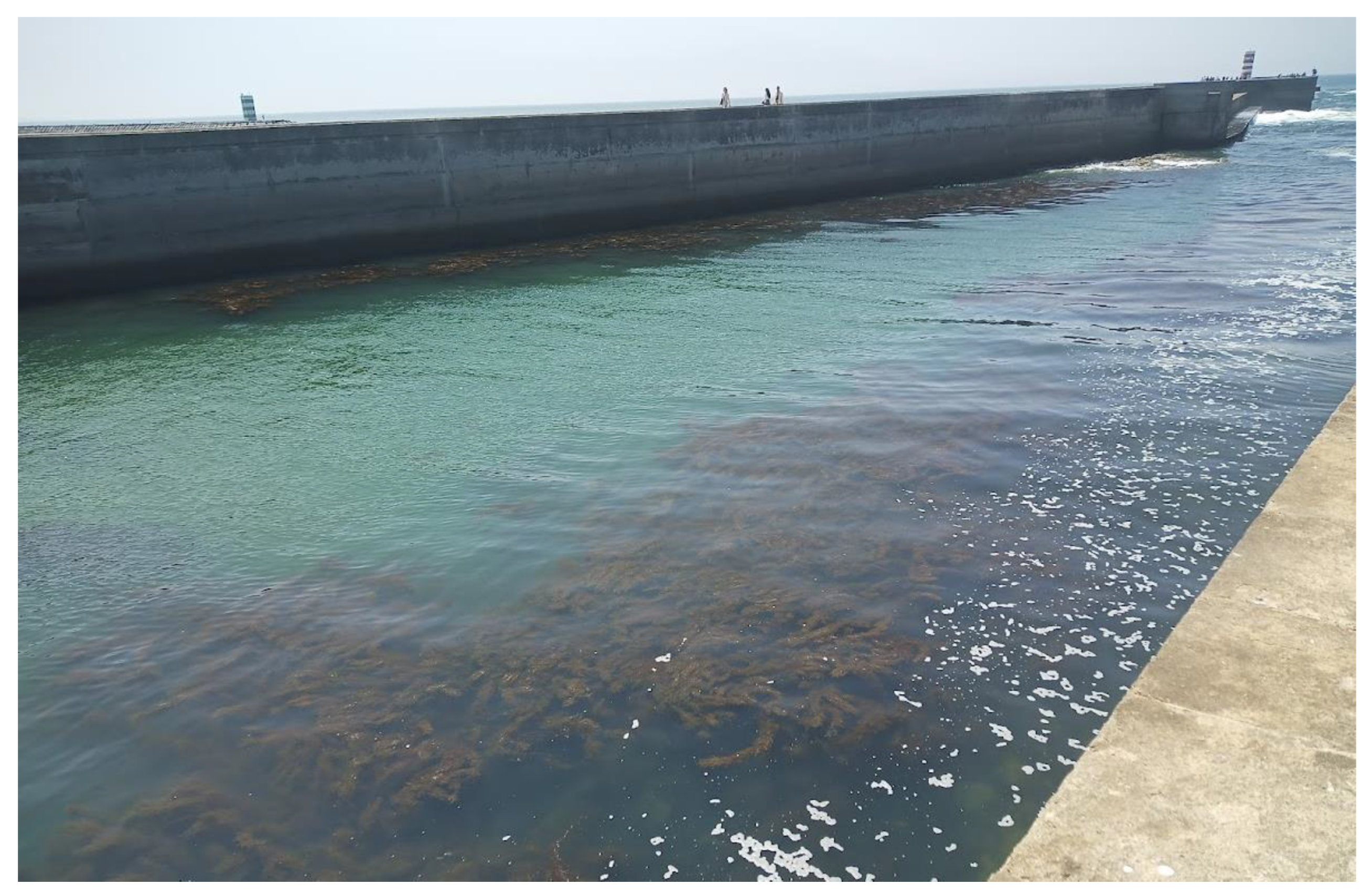

3.3. Provisioning Services
The most immediately recognized services are the direct usage of seaweeds products as food, textiles, medications, and decorations (provisioning services). These provisioning services are provided by four distinct sources. Seaweed aquaculture in the supply chain is used more in the provisioning service (Figure 4). The second supply source is related with seaweeds taken directly from nature, the biomass of which is used for a variety of uses by local populations [9]. A third source is the biomass of seaweed, which grows abundantly in nature, and in this instance, harvesting and using their biomass represents a solution to a problem (which occurs with invasive species, for example) [45][14].